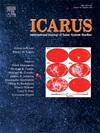How old are hermean smooth plains? A detailed study
IF 2.5
2区 物理与天体物理
Q2 ASTRONOMY & ASTROPHYSICS
引用次数: 0
Abstract
Early surface observations of Mercury by the Mariner 10 spacecraft revealed a heavily cratered surface similar to that of the Moon. Today, the high-resolution images acquired by MESSENGER spacecraft during 2008–2015, greatly enhanced our understanding of the stratigraphy, geology, and volcanic history of the innermost planet. In this study, we investigate the global distribution, origin(s), and age(s) of smooth plains (SPs) deposits on Mercury. Despite numerous studies indicating that SPs were of presumably volcanic origin, the origin of other, smaller-scale deposits remain unclear. This work examines (1) the full extent of smooth materials, regardless of their origin, by generating a new detailed global map of SPs, (2) the absolute model ages (AMAs) of 65 SP units across the mid-latitudes to test their volcanic origin, and (3) the origin(s) and age(s) of other, smaller-scale plains materials. Here, we present the first step of this global study. We find that 33.5 % of the surface of Mercury is covered by smooth plains deposits emplaced within ~100–200 My, between ~3.6 and ~3.8 Ga. This geologically short period of time for the emplacement of all SPs units across the surface of Mercury is best explained by volcanism, thus our work further supports a volcanic origin for most large-scale SPs deposits. The origin of smaller-scale SPs units and of plains materials within crater floors remains uncertain. The model ages for 10 basins and 6 crater fillings show (a) basins dating within the Mansurian-Calorian period, after the emplacement of the extensive SPs, and (b) other units with diverse origins. Three of the six crater fillings have an impact-related origin, one is likely volcanic in origin, and two plains materials are unusually old leaving their origin(s) and age(s) an open question. In the next steps, we aim to evaluate the ages of more of these plains materials distributed across the hermean surface to decipher their potential origin(s) for a complete depiction of SPs on Mercury. To assist in identifying compositionally distinct units, data from BepiColombo mission will prove to be of upmost importance in improving our understanding of the origin of all SPs.
她那平坦的平原有多少年了?详细的研究
水手10号宇宙飞船对水星的早期表面观测显示,水星表面有一个与月球相似的陨石坑。今天,信使号飞船在2008年至2015年期间获得的高分辨率图像极大地增强了我们对这颗最内层行星的地层、地质和火山历史的理解。在这项研究中,我们研究了水星上光滑平原(SPs)沉积物的全球分布、起源和年龄。尽管大量研究表明SPs可能是火山起源,但其他较小规模的沉积物的起源仍不清楚。这项工作检查了(1)光滑材料的全部范围,而不考虑它们的起源,通过生成一个新的详细的SPs全球地图,(2)横跨中纬度的65个SPs单元的绝对模型年龄(ama)来测试它们的火山起源,(3)其他较小规模的平原材料的起源和年龄。在这里,我们提出了这项全球研究的第一步。我们发现33.5 %的水星表面被平滑的平原沉积物覆盖,这些沉积物位于~100 - 200ma, ~3.6 - ~3.8 Ga之间。火山作用可以很好地解释水星表面上所有SPs单元就位的地质短时间,因此我们的工作进一步支持了大多数大规模SPs矿床的火山起源。较小规模的SPs单元和陨石坑底部的平原物质的起源仍然不确定。10个盆地和6个陨石坑的模型年龄显示:(a)盆地定年在广泛的SPs就位后的满苏里—卡罗里期;(b)其他起源不同的单元。六个火山口填充物中有三个与撞击有关,一个可能是火山形成的,两个平原物质异常古老,使它们的起源和年龄成为一个悬而未决的问题。在接下来的步骤中,我们的目标是评估分布在水星表面的更多这些平原物质的年龄,以破译它们的潜在起源,从而完整地描述水星上的SPs。为了帮助识别组成不同的单位,来自BepiColombo任务的数据将被证明是提高我们对所有sp起源的理解的最重要的。
本文章由计算机程序翻译,如有差异,请以英文原文为准。
求助全文
约1分钟内获得全文
求助全文
来源期刊

Icarus
地学天文-天文与天体物理
CiteScore
6.30
自引率
18.80%
发文量
356
审稿时长
2-4 weeks
期刊介绍:
Icarus is devoted to the publication of original contributions in the field of Solar System studies. Manuscripts reporting the results of new research - observational, experimental, or theoretical - concerning the astronomy, geology, meteorology, physics, chemistry, biology, and other scientific aspects of our Solar System or extrasolar systems are welcome. The journal generally does not publish papers devoted exclusively to the Sun, the Earth, celestial mechanics, meteoritics, or astrophysics. Icarus does not publish papers that provide "improved" versions of Bode''s law, or other numerical relations, without a sound physical basis. Icarus does not publish meeting announcements or general notices. Reviews, historical papers, and manuscripts describing spacecraft instrumentation may be considered, but only with prior approval of the editor. An entire issue of the journal is occasionally devoted to a single subject, usually arising from a conference on the same topic. The language of publication is English. American or British usage is accepted, but not a mixture of these.
 求助内容:
求助内容: 应助结果提醒方式:
应助结果提醒方式:


